| Ananda Marga Caryácarya Part 3 | ||
|
This volume deals with all the dos and dont’s related to physical health which must be followed for progress in mental and spiritual sádhaná.
|
First pour water on the navel. Then wet the region below the navel by splashing water from the front. Then pour water from behind. Thereafter pour water on the crown of the head in such a way that it trickles down over the backbone. Then bathe all over.
If you want to take a dip bath, first pour water over the waist, on the navel region, and below, in the above-mentioned way, and then take the dip.
After finishing your bath, before drying your body, recite the following mantra while performing the prescribed mudrá and looking at any luminous object:
Pitr puruśebhyo namah rśi devebhyo namah.
Brahmárpanaḿ Brahmahavir Brahmágnao Brahmańáhutam.
Brahmaeva tena gantavyaḿ Brahmakarma samádhiná.(1)
Repeat the mantra together with the mudrá three times.
Remembering the rśis and ancestors in this way is known as Pitr Yajiṋa. Pitr Yajiṋa should be performed as a daily duty even if one’s father is alive.
The mudrá should be performed according to the illustrations.
One must recite each portion of the mantra as shown by the illustrations. The arrows indicate the intended direction of movement of the hands to reach the next position. Remember that this is to be done at the end of the bath.
Sick persons who are sensitive to cold should take their bath in warm water and in an enclosed and covered place. Sun-warmed water is also good.(2) In extremely cold climatic conditions warm water should be used.(3) If you are not taking a dip bath you should bathe in a sitting position; it is desirable not to bathe standing.
Bathing at midnight is prohibited. One must not take a bath in the midnight sandhyá. Everyone must bathe in any one of the other three sandhyás. Taking into consideration one’s health and the climatic conditions, one may also bathe in one or both of the remaining two sandhyás.
The four sandhyás:
(1) The period from forty-five minutes before to forty-five minutes after sunrise is called “dawn”, and dawn is the first sandhyá.
(2) The period from 9 A.M. to 12 noon is called the noon sandhyá.
(3) The period from forty-five minutes before to forty-five minutes after sunset is called the evening sandhyá.
(4) The period from forty-five minutes before to forty-five minutes after 12 midnight is called the midnight sandhyá (11:15 P.M. to 12:45 A.M.).

Footnotes
(1) Meaning of the mantra:
Salutations to the ancestors, salutations to the god-like rśis. (Those who, by inventing new things, have broadened the path of progress of human society, are known as rśis.)
The act of offering is Brahma; that which is offered is Brahma; the One to whom the offering is made is Brahma; and the person making the offering is Brahma.
One will merge in Brahma after completing the duty assigned to him/her by Brahma.
(2) The water temperature should always be less than body temperature.
(3) The water temperature should always be less than body temperature.
|
Before eating do vyápaka shaoca properly with cold water. In an extremely cold climate use lukewarm water. The system is: Wash the arms, the face, the legs, the neck and the genital organs. Then, keeping the eyes wide open, hold a mouthful of water and gently splash the eyes a minimum of twelve times.
Before sitting down for a meal, invite whatever persons are present around you and share your food with them. If they do not want to share, enquire whether they have enough food with them or not.
At the time of eating find a comfortable sitting position. It is better to eat in company than to eat alone. Do not sit down to eat if you are in an angry mood or in a debased frame of mind.
If several people are eating together from the same plate, make sure that sick persons do not take part. Otherwise healthy persons may become infected. There is no harm, however, in eating together from the same plate if there is no contagious disease among the participants. Rather, this is a nice thing to see.
It is good to take food when the main flow of breath is through the right nostril. Even after meal, it is good if the flow of breath is mainly through the right nostril and continues for some time, because that is the time when the digestive glands start secreting a sufficient quantity of fluids to help digestion.
Eating when one is not hungry or only half-hungry is very harmful to the health. So is eating rich food for days together or over-eating tasty and sumptuous food out of greed, or not taking rest after the meal before running off to the office, or filling the stomach with food. All these habits are harmful to the health.
(For proper digestion, fill the stomach halfway with food, one quarter with water, and leave one quarter full of air.)
After finishing the evening meal take a short walk. This is very beneficial to health.
Áhárya
In every object of the universe, one of three attributes – sattva, rajah and tamah – will always be predominant. So food is also divided into three categories according to the dominancy of the attributes.
(1) Sáttvika Áhára: All the staple food-grains such as rice, wheat, barley, etc.; all the pulses except masúr [an orange-coloured lentil] and khesári; all fruits and roots; all kinds of vegetables except violet-coloured carrots, white brinjals [white eggplants], onions, garlic and mushrooms; milk and milk products; all green and leafy vegetables except red puni and mustard.
All varieties of spices except garam masalá(1) and all kinds of sweets, can be taken.
A sáttvika diet is required for those who practise ásanas. Those who find it difficult to give up the habit of rájasika food all of a sudden may eat a piece of haritakii [myrobalan] after the meal. Those who take sáttvika food should avoid taking a large quantity of mustard or mustard products. Rájasika food-eaters should gradually try to change over to sáttvika food and támasika food-eaters should try to give up such food as early as possible.
For the avadhútas and avadhútikás of Ananda Marga there is only one kind of food, sáttvika food.
All foods that are beneficial to both body and mind are considered sáttvika.
(2) Rájasika ahára: Any food that is beneficial to the body but is neutral to the mind, or vice versa, is called rájasika. Foods that do not fall into the sáttvika or támasika categories are of rájasika nature. In certain countries where there is a heavy snowfall, rájasika food can be treated as sáttvika and támasika food as rájasika.
(3) Támasika áhára: All kinds of foods which are harmful to either the body or mind and may or may not be harmful to the other are called támasika.
Stale and rotten food, the flesh of large animals such as cows and buffaloes, and all types of intoxicants, are categorized as támasika.
Small amounts of tea, cocoa and similar drinks which do not excite a person to the point of losing his/her senses are in the rájasika category. The milk of a newly-calved cow, white brinjals, khesárii dál, green vegetables of the type of red puni or mustard are támasika. Masúr dál cooked for one meal will become támasika by the next meal.
Meat-eating
Persons who have a strong desire for eating meat and those who eat meat out of necessity shall eat only meat from a male or castrated animal. No one should knowingly eat the meat of a female animal. One should not eat even a domestic female fowl.
Do not kill a fish which is one-fourth or less of its normal adult size. Also, do not kill a fish if it is in its infancy or its pregnancy. For instance, at present the female hilsá fish of the Indian Ocean is normally pregnant or in its post-delivery state from Sháradotsava [mid-autumn] to the full moon of the Indian month of Phálguna.
Footnotes
(1) A hot mixture including cardamom, cloves and cinnamon. –Trans.
|
Voluntary fasting on certain days is called “upavása”. The derivative meaning of the word “upavása” is to remain in proximity to Iishvara; that is to say, to keep one’s mind absorbed in the thought of Iishvara. Those who have received initiation into Ananda Marga Iishvara Prańidhána must observe fasting compulsorily on all ekádashii days (the eleventh day after the new or full moon). Sannyásiis and renunciants must also fast on all púrńimá and amávasyá days.
On a fast day no food is to be eaten from sunrise until sunrise of the next day. Drinking water is also forbidden on fast days. If, due to unavoidable circumstances, a person is unable to fast on the prescribed day, then he or she must fast on either the preceding or the following day. During sickness, fasting is not required, but in such cases written permission will have to be obtained from the Dharma Pracára Secretary of the Saḿgha.
On and around the times of new and full moon, one may observe that the gaseous and aqueous factors in the body rise up into the head and chest, creating an uncomfortable feeling. Therefore, if a person does not take food at these times, these factors will be drawn down from the higher portions of the body to the lower portions, thereby alleviating the uncomfortable feeling.
The food that we take is converted, through transformation, into its final essence, called shukra. Shukra is the food of the brain. From it, the ectoplasmic particles of the unit mind are produced. If one fasts according to the system, no excess shukra will excite the lower vrttis of the mind, and the mind will be led toward the higher vrttis. Furthermore, as a result of fasting, the poisonous and unnecessary waste of the body gets destroyed and expelled. Moreover, the energy that is not expended in digesting food can be utilized for other purposes. Therefore, a fast day is an excellent time for sádhaná.
|
Pure and fresh air has the power to cure disease. It is advisable to breathe in as fully as possible, because when we do so, the air gets an opportunity to be completely absorbed by the lungs. It is better to take a walk in the fresh air than to ride a vehicle. If the body does not work up a sufficient sweat, then you should know that you have not taken the air properly.
|
The essence of blood, when transformed, becomes shukra, and this shukra is food for the brain. In the absence of shukra, or in case of its impaired functioning, the entire constitution may be impaired, the body may become susceptible to disease, and mental and spiritual sádhaná may be impaired. Therefore, restraint is a must for every man and woman, because only self-control helps achieve the maximum preservation of shukra.
In the human body, one day’s shukra becomes surplus in every twenty-eight days. In the case of unmarried males, this excess shukra is either passed out with the urine or expelled while dreaming. It is not at all abnormal for an unmarried male to have a seminal discharge three or four times a month.
In the case of married persons, sexual relations in excess of four times a month can lead to an improper waste of shukra. So as regards the question of restraint and lack of restraint, the more one practises restraint, the greater will be his or her well-being.(1)
For married persons:
Keeping in view the progress of society, fit persons should have more children and unfit persons should have less.
Of course, for want of proper education even the children of fit parents may become a liability to the society rather than an asset. Hence it is better to restrict oneself to producing that number of children for which proper upbringing is possible. But at the same time, attempts at birth control by physical damage to men or women, or by permanent destruction of their procreative capacity, can never be supported, because such attempts may bring about a severe mental reaction in them at any time. But if one has to accept permanent birth control for some special reason, then permission should be requested from the ácárya. The ácárya in such cases will ascertain the views of the Ácárya Board and then guide the person.
Footnotes
(1) N.B.: Many people give the meaning of the word “Brahmacarya” as “the preservation of shukra”, but neither of the two words “Brahma” and “carya” has any relation with the retention of shukra. “Brahmacarya” means “to keep the mind attached to Brahma”. Actually the former, so-called Brahmacarya is divided into two classes called naeśt́hika and prájápatyá. Those who are unmarried will follow naeśt́hika Brahmacarya. That is to say, they will never let shukra be wasted beyond the normal surplus. And those who are married will follow prájápatyá Brahmacarya, i.e., they will try not to have sexual relations more than four times in a month.
|
(1) Body and clothing must be kept neat and clean.
(2) After urinating use water or cleanse yourself by some other means.
(3) Pay attention to the regular clearing of the bowels.
(4) Do not sleep on a soft bed.
(5) When taking a bath, all parts of the body, in particular the armpits and groin, should be cleaned properly. Soap, oil, and comb should be used every day. The body hair should never be cut, especially in the armpit and pubic region.
(6) Before morning and evening sádhaná, either do vyápaka shaoca or take full bath.
(7) Before and after meals, and before sleep, do vyápaka shaoca with cold water. If it is very cold, use lukewarm water.
(8) Drink a sufficient quantity of water every day, but do not drink too much at any one time.
(9) Sleeping during the day and staying awake at night are to be avoided.
(10) All intoxicants are támasika and are to be discarded like poison.
For males:
(1) Immediately upon reaching adolescence (in India, one reaches adolescence in between the ages of twelve and fourteen), males should start using Kaopiina (laungot́á) and should pull back the foreskin of the penis.
(2) The foreskin should be pulled back and the area washed and kept clean.
(3) Never indulge in bad practices, such as masturbation, etc.
For females:
(1) Women must make it a habit to spend some time outdoors every day in the open air and the sunshine.
(2) The best room of the house should be used for giving birth.
(3) During the period of menstruation:
(a) Women must not bend forward to lift heavy loads and utensils.
(b) They must not touch any adult male.
(c) They should not blow conch shells or sing loudly.
(d) They should not remain in close proximity to fire.
(e) They should eat nutritious and easily-digestible food.
(f) They should not exert themselves excessively.
If mothers are not healthy themselves, their children cannot remain healthy. So a mother who has the welfare of her children uppermost in her mind should keep a careful watch on her own health. A woman should be allowed to rest and abstain from all sorts of household chores for at least twenty-one days after childbirth.
(g) Ashokaśaśt́hii and Ashokáśt́amii observances:(1)
On the Ashokaśaśt́hii day every menstruating woman should take in one gulp six mung or máśakalái seeds along with six ashoka flowers or buds. They should be taken either in a ripe banana or with water or milk. Similarly, on the Ashokáśt́amii day, eight mung or másakalái seeds and eight Ashoka flowers or buds should be taken.
(4) Married women and widows should also observe Ashokaśaśt́hii and Ashokáśt́amii vows. On other śaśt́hii days they should eat fruits and roots instead of rice and bread during the day, and in the evening must never eat rice or similar preparations.
For children:
The main diet for children who are under five years of age is milk, fruits and roots. It is not proper, under any circumstances, to offer non-vegetarian food to children who are under five years of age. When they have reached the age of five, food containing sugar, starch and fatty substances can be given in increasing amounts. Alkaline food is the most beneficial for children.
It is also good to give lime-water(2) (after the lime sediments have settled) to children from time to time.
It is particularly beneficial for children to spend some time every day in the fresh air and sunshine.
Footnotes
(1) Where the items to be taken on these days are not easily obtainable, the women of that place are not required to take them.
(2) I.e., mineral lime.
|
Everyone may perform the practices below if they wish.
(1) Utkśepa Mudrá: This mudrá should be practised in bed immediately upon waking. While lying on the back, one should flex both the arms and legs, bringing them over the chest, and then return them immediately to the extended position. After doing this three or four times, sit up in bed and drink a glass of cold water without allowing the water to touch the teeth. After this you should expose the navel area to the air, and walk up and down in this way for some time in the open air.
(2) Vasti Mudrá: While defecating, keep the genital organ pointed upward, pressing its base with the middle finger of the left hand and pressing the scrotum with the rest of the fingers. This is as good as using a kaopiina. Remove the hand while urinating.
(3) Múlashodhana: After defecating, insert the middle finger of the left hand as far up the rectum as possible and clean that area.
(4) Násápána: Draw in clean water through the nostrils and pass it out through the mouth. This water may be swallowed, but it is better to spit it out.
(5) Dhaotii: Immediately after násápána, at a time when your stomach is empty and you are washing your face, the throat should be cleaned with the middle finger of the right hand, inserting it as far as possible.
The practices given below are prescribed only for specific diseases. Therefore, they are to be performed only after consultation with an ácárya.
(1) Vistrta snána or vyápaka snána: A bathtub is most convenient, but if this is not available, an earthen trough will suffice. If this is not available either, a wet towel can be used, soaking it repeatedly in water. Fill the bathtub with cold water, and sit in it undressed so that the area from the navel down remains submerged. Keep your feet dry and out of the tub. The area from the neck to the navel should be kept covered with a shirt or dry cloth. The crown of the head and the back of the head should be kept covered with a wet towel.
Now take another towel and rub the area from the right side of the abdomen to the groin seven or eight times. Do likewise on the left-hand side and horizontally from right to left and left to right. You should make sure that the towel on the head remains wet.
After this, wipe the abdomen, hands and thighs and take a full bath. If this is not possible, then leave the tub wearing a shirt.
This should be practised behind closed doors. In the absence of a bathtub or an earthen trough, a wet towel may be wrapped around the areas to be bathed, but in order to compensate, cold water must be poured constantly over the towel, and the towel which is to be used for the massage must be kept wet. After vyápaka snána, the thighs, pubic area and abdomen should be warmed with a dry towel.
Before and after this bath one should not eat, in order to allow the stomach to rest.
(2) Shiitośńa snána: In an enclosed and covered place, immerse the body up to the neck in a tub or a trough containing warm water, and pour a stream of cold water over the head.
(3) Sikta mardana: Massage the body with a wet towel in the same manner as prescribed after ásanas.
(4) Átapa snána: The meaning of átapa snána is “sun-bathing”, but sunshine is not the same for all countries at all times. Therefore, it is not possible to fix the best time for sun-bathing. So, at the present time, in the plains of Bihar, a sun-bath can be taken during the summer until 10 A.M. and during the winter between noon and 2 P.M.
During the sun-bath, the diseased parts of the body are exposed to the sun’s rays while the remaining parts are kept in the shade. When the affected area becomes hot after leaving it in the sun for fifteen to twenty minutes, it should be brought into the shade and the procedures described below followed. (a) If there is rheumatism or gout in that part of the body, that part should be massaged thoroughly with oil for four or five minutes.
(b) If it is skin disease then that area should be massaged with neem oil for four or five minutes.
(c) In the case of other diseases, the affected area should be massaged with a cool, wet towel that has been wrung out.
After the temperature of the area has come down to normal, it can once again be exposed to the sun’s rays. After leaving it in the sun for fifteen to twenty minutes, again cool the area by massaging with oil or a towel in the aforesaid manner. Exposure to sun and massage can be done in the same manner again and again. But during the last massage, instead of using oil, etc., it is desirable to wipe with a wet towel in all cases except that of skin disease.
If a healthy or sick person so desires, he or she may take a sun-bath over the entire body. In this case, after the completion of the sun-bath, the whole body must be thoroughly wiped off with a wet towel. When taking a sun-bath over the entire body, one should wear little or no clothes and keep the back to the sun. If the diseased area is in the front portion of the body, that is to say, the face, chest, stomach, etc., then it can be kept uncovered but the remaining portions must be kept covered.
One should always remember, “Expose the stomach to fire and the back to sun;” i.e., if you need to warm yourself at a fire, keep the stomach towards the fire, never the back.
|
“Ásana” means “a position in which one feels comfortable” – “Sthirasukhamásanam.” Ásanas are a kind of exercise by regular practice of which the body stays healthy and hardy and many diseases are cured. But ásanas are not prescribed for the general cure of diseases; only those diseases which create trouble in the path of meditation may be cured by the help of specific ásanas, so that sádhaná may more easily be done.
The relation between the physical body and the mind is very close. Mental expression is brought about through the vrttis, and the predominance of the vrttis depends on different glands of the body. There are many glands in the body and from each there is a secretion of a particular hormone. If there is any defect in the secretion of hormones or any defect in a gland, certain vrttis become excited. For this reason, we find that in spite of having a sincere desire to follow the moral code, many persons cannot do so; they understand that they should do meditation, but they cannot concentrate their minds because their minds become extroverted due to the external excitement of this or that propensity. If a person wants to control the excitement of these propensities, he or she must rectify the defects of the glands. Ásanas help the sádhaka to a large extent in this task, so ásanas are an important part of sádhaná.
A list of ásanas is given below. The same ásanas are not necessary for everyone. There are more than 50,000 ásanas; among them a few are named here which are most necessary for the path of meditation. The ácárya will teach particular ásanas to a person according to his or her need.
There are many ásanas whose forms are similar to those of different animals, and therefore they are called by the names of those animals. And there are many characteristics found in animals and birds which are not commonly found in human beings: the physical structures of those animals and birds are such as to further certain glandular secretions, and as a result certain special qualities are developed.
The tortoise can easily retract its extremities. If human beings can also sit in that way for some time, they can withdraw their minds from the external world. The name of that posture is kúrmakásana (tortoise posture).
Rules for ásanas:
(1) Before practising ásanas, do vyápaka shaoca or take a full bath. Vyápaka shaoca must also be done before daily meditation; if ásanas are done with daily meditation then it is not necessary to do vyápaka shaoca separately.
(2) Do not practise ásanas in an open place, because it may result in sudden exposure and thereby you may catch cold. While practising ásanas indoors, attention should be paid to keep the windows open so that air can pass through.
(3) No smoke should be allowed to enter the room. The less smoke the better.
(4) Males must wear a Kaopiina (laungot́á), and there should be no other clothing on the body. Females must wear tight-fitting underwear and a bra.
(5) Practise ásanas on a blanket or a mat. Do not do ásanas on the bare ground, because you may catch cold, and some secretions which come from the body while practising ásanas may be destroyed.
(6) Practise ásanas only while breath is flowing through the left nostril or both nostrils; do not practise ásanas when the breath flows only through the right nostril.
(7) Take sáttvika food. But a person for whom it is difficult to give up rájasika food can for the time being take a small piece of myrobalan (it is better to use the small type of myrobalan), or something of a similar nature, after meals. However, this procedure does not apply in cold countries.
(8) Do not cut the hair of the joints of the body.
(9) The nails of the fingers and toes must be kept cut short.
(10) Do not practise ásanas on a full belly. It is prohibited to perform ásanas for two-and-a-half to three hours after a meal.
(11) After practising ásanas, you should massage your arms, legs and entire body, especially the joints, very well.
(12) After the massage is finished, remain in shavásana (corpse posture) for at least two minutes.
(13) After shavásana do not come in direct contact with water for at least ten minutes.
(14) A practitioner of ásanas should not massage his or her body with oil. If you like you may rub oil lightly over the body.
(15) After practising ásanas, it is desirable to walk in a solitary place for some time.
(16) Just after ásanas práńáyáma is prohibited.
(17) If it is necessary to go outdoors after practising ásanas and if at that time the body temperature has not come down to a normal level, or if there is any difference between the room temperature and the outside temperature, you must cover your body when going out. If possible, inhale a deep breath inside the room and exhale it after coming outside. In that way there will be no chance of catching cold.
(18) It is not prohibited for the practitioner of ásanas to practise free-hand exercise, running or sports, but just after ásanas all these are prohibited.
(19) There is no restriction of nostril for the following ásanas: padmásana (lotus posture), siddhásana (siddha posture), ardhasiddhásana (half siddha posture), bhojanásana (cross-legged sitting posture), viirásana (viira posture), diirgha prańáma (long bowing posture), yogásana (yoga posture) and bhújauṋgásana (snake posture).
(20) For all those ásanas where there is no restriction of nostrils, there is no restriction on food either.
(21) During menstruation, pregnancy and within one month of delivery, women must not practise ásanas or any other exercise. The ásanas for dhyána can be done under all conditions – padmásana, siddhásana and viirásana are the proper ásanas for dhyána and dhárańá.
List of ásanas (for illustrations, see bottom of page):
No one should risk harm by practising ásanas and mudrás without the permission of an ácárya.
(1) Sarváuṋgásana (all-limbs posture):
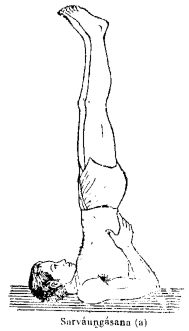
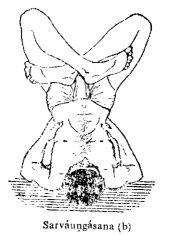
(a) Lie down on your back. Gradually raise the entire body and keep it straight, resting its weight on your shoulders. The chin must be in contact with the chest. Support both sides of your trunk with your hands. The toes must remain together; the eyes must be directed at the toes.
(b) Lie down in padmásana. Gradually raise the body and rest its weight on your shoulders. Support both sides with the hands. This ásana is also known as úrdhvapadmásana (inverted lotus posture).
Practise three times, up to five minutes each time.
(2) Matsyamudrá (fish posture): Lie down in padmásana. Rest the crown of the head on the floor and grasp both the big toes with the hands. Practise three times. Maximum time for practice is two-and-a-half minutes.
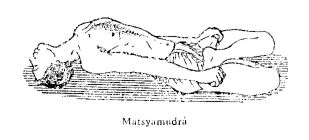
(3) Matsyásana (fish posture): Lie down in padmásana. Grasp each shoulder with the opposite hand from behind. The head will rest on both the forearms. Practise three times, each time for half a minute.
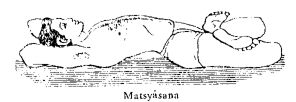
(4) Matsyendrásana (Matsyendra’s posture): generally for males:
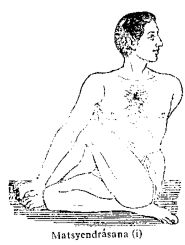
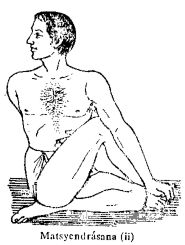
(i) Press the múládhára cakra with the right heel. Cross the left foot over the right thigh and keep it to the right of the thigh. Grasp the left big toe with the right hand, keeping the right arm along the left side of the left knee. Reach backwards from the left side with the left hand and touch the navel.
Turn the neck to the left as far as possible.
(ii) Then press the múládhára with the left heel and reverse the process. One round means completing the process on both sides.
Practise four rounds, half a minute each time.
(5) Viirásana (viira posture): Kneel down and sit on the heels. Bend the toes downwards. Rest the backs of the hands on the thighs, the fingers pointing towards the groin. Direct the vision at the tip of the nose. The ácárya will give directions as to the duration of this ásana.

(6) Cakrásana (wheel posture): Lie in a supine position. Flex the legs to bring the lower legs in contact with the thighs. Both the hands will rest close to the shoulders. Supporting the weight on the soles and the palms, raise the head and the trunk. The body will assume the shape of a wheel in this ásana. Duration – half a minute. Practise four times.
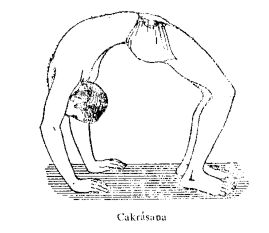
(7) Naokásana (boat posture) or dhanurásana (bow posture): Lie in a prone position. Flex the legs to bring the lower legs close to the thighs. Directing the hands over the back, grasp the ankles. Raise the entire body, supporting the weight on the navel. Extend the neck and chest as far back as possible. Look towards the front. Breathe in while raising the body and maintain yourself in that state for eight seconds. Resume the original posture while breathing out. Practise the ásana eight times in this manner. The body assumes the shape of a bow during this ásana.
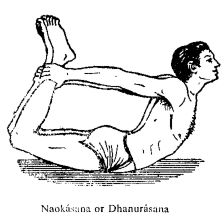
(8) Utkat́a pashcimottánásana (difficult back-upwards posture): Lie in a supine position and extend the arms backwards, keeping them close to the ears. Rise while exhaling and insert the face between the knees. Make sure that the legs remain straight. Grasp both the big toes with the hands. Remain in this state for eight seconds. Now resume the original posture while inhaling. Practise eight times in this way.
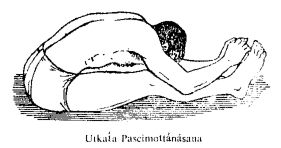
(9) Parvatásana (mountain posture) or halásana (plough posture): Assume the position of sarváuṋgásana. Gradually bring the legs backwards and extend them as far as possible. Let the toes of both feet touch the ground. Keep both the hands in a prone position on either side of the body. Duration – as in the case of sarváuṋgásana.
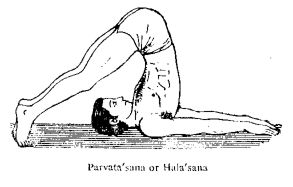
(10) Shivásana (Shiva posture): Assume the position of Parvatásana. Bend the knees until they come close to the ears. Do not place the hands as in parvatásana, but interlock the fingers firmly and keep the hands in contact with the ground. Duration – as for sarváuṋgásana.

(11) Vajrásana (thunder posture): Bend the right leg at the knee and direct the foot backwards, in such a way that it does not touch the right thigh. Supporting the weight on both the hands, direct the left foot backward in the same way. Now gradually sit on the floor. Raise the hands and place them on the knees. In the beginning practise this ásana very cautiously. Injury may result from trying to squat forcibly. Duration – half a minute. Practice four times.
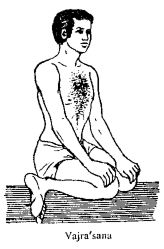
(12) Siddhásana (siddha posture): Press the múládhára cakra with the left heel. Then press the svádhiśt́hána cakra with the right heel. Place the hands palm up on the respective knees. Duration – as long as you wish.
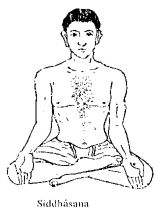
(13) Baddha padmásana (bound lotus posture): Assume the position of padmásana. Direct the right hand backwards from the right side and grasp the right big toe. In the same way, direct the left hand backwards and grasp the left big toe. Duration – half a minute. Practise four times.
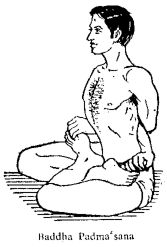
(14) Kukkut́ásana (cock posture): Assume the position of padmásana and insert the hands and forearms in between the respective lower legs and thighs. Then raise the whole body, supporting the weight on the hands. Look forward. Duration – half a minute. Practise four times.
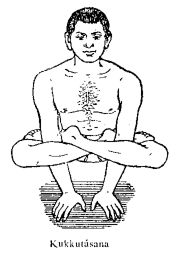
(15) Gomukhásana (cow’s head posture):
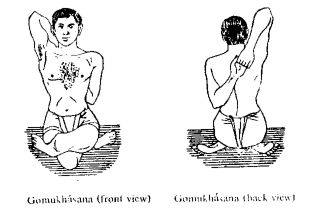
(i) Sit down and extend the legs forwards. Bring the right leg under the left thigh, placing the right foot under the left buttock. Now bring the left leg across the right thigh and place the left foot under the right buttock. Place the left hand on the spine. Then bring the right hand backward over the right shoulder and interlock the fingers of the hands in a chain-like fashion.
(ii) Practise in the same way with the left leg under the right leg. Completing this on both sides constitutes one round.
Duration of each position – half a minute. Practise four rounds.
(16) Mayúrásana (peacock posture): Assume a squatting position. Bring the wrists together and place the palms on the floor, with the fingers pointing towards the feet. Now bring the elbows in contact with the navel and stretch the legs backward. Supporting the weight on the elbows, raise the head and the legs from the floor. Duration – half a minute. Practise four times.
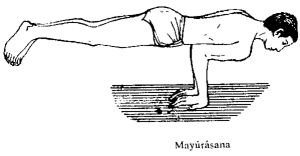
(17) Kúrmakásana (tortoise posture): Assume the position of padmásana. Insert both the forearms in between the lower legs and the thighs. Then grasp the neck with both the hands. Both the elbows will touch the floor, and the head will be bent forward. Look steadily in front as far as possible. Duration – half a minute. Practise four times.
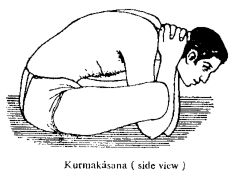

(18) Sahaja utkat́ásana (simple chair posture): Seat yourself as if in a chair (but actually there will be no chair). Keep the arms straight to conform to the arms of the chair. Duration – half a minute. Practise four times.

(19) Shalabhásana (locust posture): Lie down on your chest. Stretch the hands backward with the palms upward. Raise the legs and the waist, keeping the fists clenched. Duration – half a minute. Practise four times.
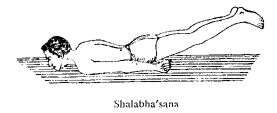
(20) Bhújauṋgásana (snake posture): Lie down on your chest. Supporting the weight on the palms, raise the chest, directing your head backward. Look at the ceiling. Breathe in while rising, and after having risen, hold your breath for eight seconds. Come down to original position while breathing out. Practise eight times.
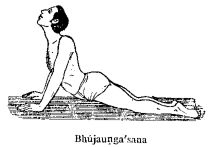
(21) Shasháuṋgásana (hare posture): Kneel down and grasp both the heels firmly. While exhaling, bring the crown of the head into contact with the floor in a posture of bowing down. The forehead should touch the knees. Maintain this posture for eight seconds, holding the breath. Breathe in while rising. Practise eight times.
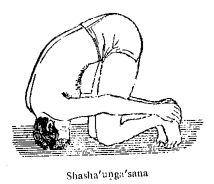
(22) Bhastrikásana (bellows posture): Lie on your back, and while breathing out, bend the right leg and bring the thigh into contact with the chest. Grasp the leg firmly with both hands. Maintain this position for eight seconds, holding the breath. Resume original position while breathing in. Practise similarly with the left leg, and then with both legs together. One round comprises this process with the right leg, the left leg, and both legs together. Practise eight such rounds, i.e. 8 x 3 = 24 positions.


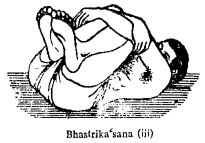
(23) Jánushirásana (head-to-knee posture): Press the múládhára with the right heel. Extend the left leg forward. While exhaling, touch the left knee with the forehead. Then, interlocking all the fingers firmly, press the left sole with the hands. There should be complete expiration when the forehead touches the knee. Maintain this position for eight seconds. Separate the hands and sit erect, while breathing in. Then press the múládhára with the left heel and repeat the above process exactly. One round comprises practising once with the left and once with the right leg. Practise four rounds.
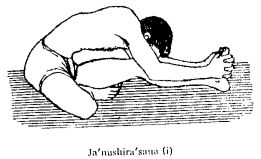
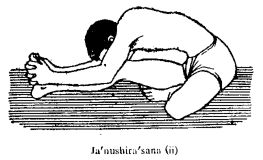
(24) Ardhashivásana (half Shiva posture): The only difference between this ásana and Shivásana is that in Shivásana, while the legs are bent close to the ears, the feet remain on the ground; whereas in this ásana while the knees are kept close to the ears, the legs are extended upwards as in the case of sarváuṋgásana. Duration – half a minute. Practise four times.
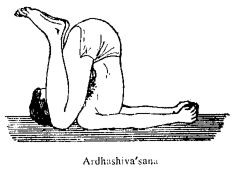
(25) Ardhakurmakásana (half tortoise posture) or diirgha prańáma (long bowing posture): Kneel down, and holding the palms together, extend the arms upward, keeping them close to the ears. Then bend forward in a posture of bowing down, touching the floor with the tip of the nose and the forehead. The buttocks must continue to touch the heels. While bending down breathe out and stay in a state of complete exhalation for eight seconds. Then rise up, breathing in. Practise eight times.
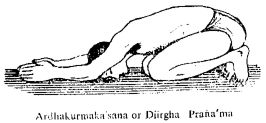
(26) Yogásana or yogamudrá (yoga posture): Sit in bhojanásana. Pass both hands backward and grip the left wrist with the right hand. Then bring the forehead and the nose into contact with the floor, breathing out during the process. Maintain this state for eight seconds and then rise up, breathing in. Practise eight times.

(27) Tuládańd́ásana (balance posture):
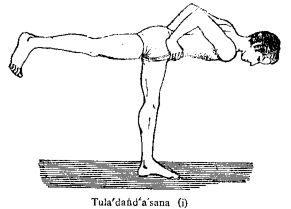
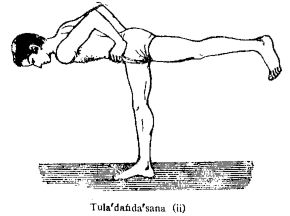
(i) Standing on the left foot, direct the other foot backward and raise it. Grasp the waist on either side with the respective hand, and then bend the trunk and the head forward such that the head, the trunk and the leg (extended backward) are parallel to the floor.
(ii) Standing on the right foot, repeat the process. Duration – half a minute. Practise four times.
(28) Uśt́rásana (camel posture): Lie in a supine position. Raise the extended legs from the floor in such a way that they form an angle of 30 degrees. In the meantime keep both the arms extended, touching the sides. Duration – half a minute. Practise four times.
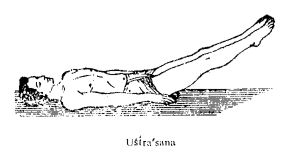
(29) Utkat́a kúrmakásana (difficult tortoise posture): Bring the right leg over the right shoulder. Then bring the left leg over the left shoulder and place it on the right ankle. Interlock the fingers firmly and hold them forward in the namaskára position. Duration – half a minute. Practise four times.

(30) Jat́ila utkat́ásana (difficult chair posture): Squat down, supporting the entire weight of the body on the big toes. Grasp the waist on each side with the hands, the buttocks resting on the heels. Duration – half a minute. Practise four times.
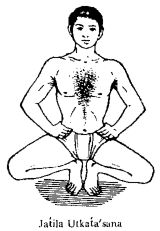
(31) Utkat́a vajrásana (difficult thunder posture): Lie down in vajrásana. Place the arms as in matsyásana. Duration – half a minute. Practise three times.
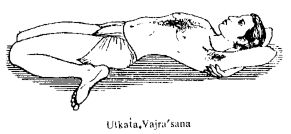
(32) Padahastásana (arm-and-leg posture): Stand erect, raising the arms, palms open. Then bend the trunk and the left arm leftwards while breathing out, and in a state of full expiration touch the left foot with the left hand. After maintaining this position for eight seconds, raise the body and extend the left arm upwards, breathing in throughout the process. When the body is perfectly erect again, bend the trunk and the right arm rightwards, breathing out, and, in a state of complete expiration, hold for eight seconds, touching the right foot with the right hand. Then raise the trunk, extending the right arm upwards, inhaling throughout the process. Then bend the trunk forward, breathing out in the process, and catch hold of the big toes. Stay in this position for eight seconds. Then, breathing in, rise up, and raise the arms and extend them backward. When you cannot bend any farther back, hold yourself in that position for eight seconds, retaining the breath. Then bend forward while breathing out, and, just touching the big toes (i.e., without staying in that position), raise the trunk and the arms, breathing in. One round is then complete. Practise eight rounds, making sure that no part of the body below the waist is bent at any time.
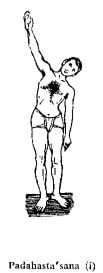
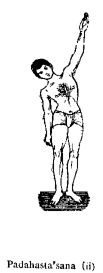


(33) Shavásana (corpse posture): Lie quietly on the back like a corpse and imagine that you are dead. Keep the arms away from the chest, on the floor, in a perfectly relaxed condition. Duration – Those for whom shavásana has been specially prescribed will practise up to ten minutes.

(34) Padmásana (lotus posture): Place the right foot on the left thigh and the left foot on the right thigh. Clench the jaws and press the tongue against the roof of the mouth. You can maintain this posture as long as you like.
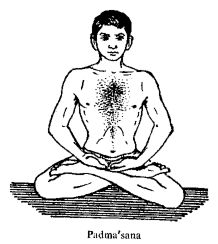
(35) Karmásana (action posture): This ásana is made up of two parts. The second part is the complement of the first. One performance of the first and second parts makes a complete round. Four rounds should be practised.
First Part
Stand upright, and placing both hands behind the back, interlock the fingers and press the palms together. Keeping the body below the navel steady, move the upper body in four directions as in padahastásana.
(i) Bend the upper part of the body leftwards, breathing out, and stay in this position for eight seconds, holding the breath. Resume original position, breathing in. Move the interlocked hands to the right when the body bends leftwards. Remember that the left arm should touch the back when the body is bent, and keep touching it while holding this position.
(ii) Practise similarly on the other side, that is, bend the upper part of the body to the right and move the interlocked hands to the left.
(iii) Bend downward exhaling slowly. As you bend lower and lower, gradually raise the interlocked hands upwards. Bring the head as low as possible and raise the arms upwards with the hands interlocked. The knees should not bend. Maintain this position for eight seconds without inhaling. Resume original position, inhaling.
(iv) Bend the upper part of the body backwards while inhaling. While bending the trunk, head and neck backwards, hold the interlocked hands straight down. Stay in this position, holding the breath, for eight seconds. Breathing out, resume original position.
Second Part
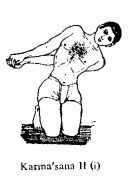

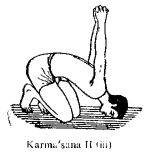
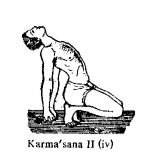
In the first part of karmásana you do the ásana standing, while in the second part you kneel down and sit on the heels. Then repeat the same exercise as in the first part, moving the body in all four directions. The toes should point forwards. The duration and manner of breathing should be the same as in the first part. In this part also the body below the navel should not bend. The second part differs from the first part as follows:
(i) and (ii) are no different from the first part.
(iii) – While bending forwards, the nose and forehead should touch the ground.
(iv) – while bending the chest and head backwards, the interlocked hands should graze the soles of the feet and touch the ground, supporting the weight a little.
(36) Jiṋánásana (knowledge posture):

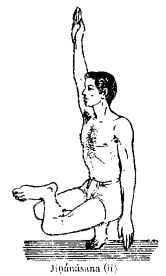
(i) Squat, sitting on the heels, with the arms a little behind the buttocks. Shift the left leg a little forward and put the right ankle on the lower part of the left thigh, just above the knee, in such a way as to form a triangle in a plane parallel to the earth. Raise the left arm upwards, touching the ear. Look forward. Keep the balance by touching the ground with the fingers of the right hand. Maintain this position for half a minute.
(ii) Repeat this process on the other side.
(i) and (ii) constitute one round, and four rounds should be practised.
(37) Bhávásana (ideation posture):

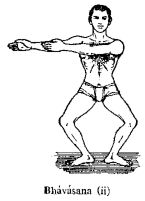

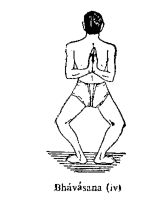
(i) Sit as in sahaja utkat́ásana, keeping the feet slightly apart and pointing in opposite directions, but instead of holding the arms parallel to each other, bring the palms together as in a greeting. Keep the vision on the trikut́i. Duration – eight seconds.
(ii) Extend both arms to the right, the left arm touching the chest and stretching rightwards as far as possible. Duration – eight seconds.
(iii) Extend the arms leftwards in the same way. Duration – eight seconds.
(iv) Put the arms behind the back and bring the palms together. Duration – eight seconds.
Practise four times.
(38) Granthimuktásana (knot-loosening posture): Stand erect. Hold your left ankle with your right hand and touch the left big toe to your right nostril, and raise the left hand straight upwards. Duration – eight seconds. In the same way, touch the right big toe to the left nostril. This makes one complete round. Practise four rounds.

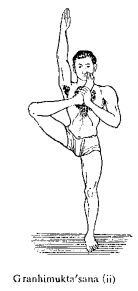
(39) Garud́ásana (bird posture): Stand erect. Stretch the right leg as far back as possible. Extend the left arm forwards and the right arm backwards, keeping both arms parallel to the ground. Then try to touch the right big toe with the right hand (it will not touch). Do not bend the body at all, but the right leg may be bent slightly upwards. The posture will resemble that of a flying bird. Duration – half a minute. In the same way, try to touch the left big toe with the left hand. These processes will make one round. Practise four rounds.

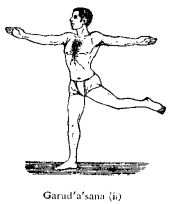
(40) Dvisamakońásana (double right-angle posture): Sit in sahaja utkat́ásana. Extend the right leg forward, parallel to the ground, and raise the left arm upwards. Hold the waist with the right hand. Duration – eight seconds. A similar process on the other side makes one round. Practise four rounds.
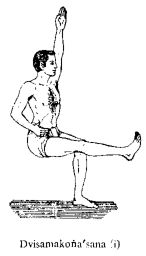
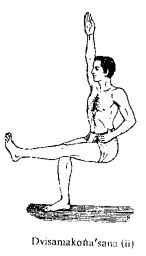
(41) Tejasásana (energy posture): Practise parvatásana, but instead of placing the hands on the floor, clasp the knees with them. Duration – two minutes. Practise three times.
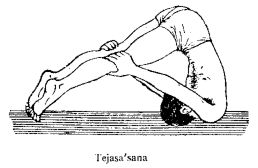
(42) Mańd́ukásana (frog posture): Sit in padmásana and, placing the arms beside the knees and under the legs, clasp the hands with your palms on the ground. Then raise the body, resting it on the palms, and skip forward three times and then backward three times. This completes one round. Practise three such rounds.
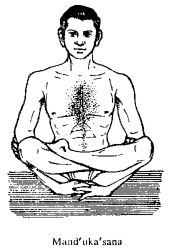
|
Mudrás are almost the same thing as ásanas but incorporate more ideation. The rules for mudrás are similar to those for ásanas, but there is no restriction regarding the nostrils. The number of mudrás is also large. A list of a few necessary mudrás is given here.
(1) Ud́d́ayana mudrá: Standing, place the hands above the knees and bend forward a little. Gradually breathe out, to a state of complete exhalation. Keeping the breath out, draw the abdomen and lower abdomen inward as hard as possible, to touch the spine. Maintain this position for eight seconds. Then gradually inhale fully. Practise eight times.
(2) Bandhatraya Yoga –
(i) Mahámudrá: Sitting down, press the múládhára cakra with the left heel and extend the right leg forward. Breathe in deeply, and at the same time contract the urinary sphincter muscles. Grasp the sole of the extended foot firmly with both hands, and maintaining jálandhara Bandha (clamping the chin against the chest), hold the breath. Retain this position for half a minute. Then relax the hands and also jálandhara bandha, and, sitting erect, breathe out.
(ii) Mahábandha: Press the múládhára cakra with the left heel and press the svádhiśt́hána with the right. Breathe in and simultaneously imagine that the urinary sphincter muscles are being raised. Apply jálandhara bandha, and after placing the thumbs over the waist, press the sides of the genitary organ with the eight remaining fingers. Maintain this position for half a minute, and then, releasing the hands and relaxing jálandhara bandha, breathe out.
(iii) Mahávedha: Press the múládhára with the left heel and the svádhiśt́hána with the right. Contract both the anal and the urinary sphincter muscles hard while breathing out. Both the thumbs will rest over the waist. With the remaining eight fingers, try to raise the anal and the urinary sphincters. Jálandhara bandha should be held in the meantime. Retain this posture for half a minute. Release the hands and jálandhara bandha, breathe in, and at the same time relax the anal and urinary sphincters.
Pressing the right heel to the múládhára in a like manner, practise mahámudrá, mahábandha and mahávedha.
(3) Párthivii mudrá: Lie on the back. Spread the arms on the floor beside the body. Close the eyes, and, concentrating the mind on the múládhára cakra, breathe in, and, without pausing, breathe out. Practise seven times.
(4) Ámbhasii mudrá: As in párthivii mudrá, but concentrate on the svádhiśt́hána cakra. Practise seven times.
(5) Ágneyii mudrá: As in parthivii or ámbhasii mudrá. Concentrate on the mańipura cakra. Practise seven times.
(6) Váyavii mudrá: Standing erect, press the nipples with the third joints of the middle fingers of both hands. The remaining fingers will stay in their natural positions on either side of the middle fingers. Now bring both the elbows backward while inhaling. After complete inhalation, exhale. The elbows should be relaxed a little when exhaling. Practise this mudrá with the eyes closed, concentrating the mind on the anáhata cakra. Practise seven times.
(7) Ákáshii mudrá: Practise this exactly like váyavii mudrá, but concentrate your mind on the vishuddha cakra. Practise seven times.
(8) Mánasii mudrá: Practise this in the same way as váyavii or ákáshii mudrá, but concentrating the mind on the trikut́i. This mudrá may be practised in a supine position like párthivii mudrá. If it is practised in a supine position, the hands should rest in relaxation on either side of the trunk. Practise seven times.
(9) Agnisára mudrá: Sitting in siddhásana, hold the waist on both sides with the hands. While breathing out, press the navel region with the middle fingers and contract it till it touches the spine. Stay in this position for a little while. Gradually resume original position. This constitutes one time. Initially practise three times and gradually increase to ten times.
(10) Kákacaiṋcu mudrá: Sit in the open air, preferably on the bank of a pond, facing it. Projecting the mouth like a beak, draw in air, producing a hissing sound, and swallow the air, imagining that the air is whirling around inside the stomach. Be sure that the hissing sound is produced during the act of inhalation. Now the air will escape from the stomach, but take no notice of it. Practise this seven times.
(11) Trimuńd́a mudrá: Sit extending both the legs together. Then pull the legs back towards the body and place the soles of the feet on the ground in such a way that the thighs form an angle of 15 degrees to 20 degrees with the lower legs. Thrusting both hands inside this angle, pass them outside the legs and grasp the opposite elbows. Both the hands should be kept below the knees. Pull both legs close to the trunk and place the chin between the knees. Duration – three minutes. To be practised four times.
(12) Ashvinii mudrá: Sitting in bhojanásana, contract and immediately relax the anal sphincter. Practise eight to ten times.
This mudrá can also be performed sitting in a pond or tub full of water.
(13) Vajrolii mudrá: During urination contract the vajrolii nádii and hold it for some time. Then release the hold. Practise three times.
This exercise can be practised when the urine is clear and its flow is normal.
After urination, be doubly sure to wash with water.
|
The process by which the práńas in the body are controlled is called práńáyáma. Práńa, apána, samána, udána, vyána, nága, kúrma, krkara, devadatta, and dhanaiṋjaya – the collective name of these ten vital forces is práńáh. If you wish to increase your apperceptive power you must control the práńáh. Through regular practice, the mind will become concentrated. Práńáyáma is meant for sádhakas – it is better for non-sádhakas not to take the risk of injuring themselves by doing práńáyáma.
Práńáyáma is also very beneficial for the physical body. Special práńáyáma practices are prescribed for specific diseases.
No one should practise práńáyáma without the permission of an ácárya.
| 1) Sádhárańa Práńáyáma | An ácárya will teach | |
| 2) Sahaja Práńáyáma | } | A purodhá will teach |
| 3) Visheśa Práńáyáma | ||
| 4) Ántarpráńáyáma |
Procedure for Sádhárańa Práńáyáma:
Closing the eyes, sit in either siddhásana, padmásana or bhojanásana. Do bhútashuddhi. After doing ásana shuddhi, concentrate your mind on the point that the ácárya will fix. Then, after doing cittashuddhi, ideate on the first syllable of your Iśt́a mantra, press and close the right nostril with the thumb of the right hand, and draw in a deep breath through the left nostril. During inhalation, ideate that infinite vital energy is entering the point from the infinite Brahma who is existing all around. After taking a full breath close the left nostril with the middle, ring and little fingers, and, taking the thumb away from the right nostril, slowly let out the air (Ideate that the infinite vital energy is returning from the point to that Infinite Brahma). During exhalation ideate on the remaining syllable of your Iśt́a mantra. When the breath has been fully expelled from the right nostril, inhale as fully as possible again through the right nostril. Afterwards, closing the right nostril with the thumb and removing the fingers, exhale the air through the left nostril. This completes one round.
For the first week, complete three rounds each time. The number is increased by one round every week until seven rounds is reached.
Práńáyáma can be practised up to four times in a day. If a person practising práńáyáma twice daily wishes to practise three times on any particular day, he/she may do so, but the person who practises twice daily must not suddenly increase to four times, because that will result in the body falling sick. Therefore it is advisable at first to do the practise twice daily, increasing it by one round per week. If, however, on any day two times práńáyáma is not completed, then at the end of the week, the number of times missed must be practised in compensation before increasing the number of rounds.
Practitioners of práńáyáma should try to keep themselves away from dust, smoke, bad-smelling environments and excessive labour. It is very helpful to take a sufficient amount of milk products for the first two months following commencement of the practice.
The following práńáyámas are prescribed for specific diseases. An ácárya will teach them. It is forbidden to practise these práńáyámas within an hour before or after the practice of práńáyáma connected with sádhaná. As far as possible it is not advisable for any person to practise more than one kind of práńáyáma.
(1) Vasti kumbhaka: Sit in the ásana given by the ácárya and inhale deeply. Now press the two principal nádiis of the scrotum with the thumbs and the forefingers of both hands and exhale gradually. Practise this seven times.
(2) Shiitalii kumbhaka: Sit in padmásana. After closing both the nostrils and sticking out the tongue, inhale as deeply as possible the cool air of the morning, evening or midnight hours. Keeping the nostrils and mouth closed, hold the breath for eight seconds, then exhale gradually through the nose. Do this eight times continuously. After completion, massage the diseased portion of the body.
(3) Siitkárii kumbhaka: Sit in padmásana. Breathe in through the nose and, closing your nose and mouth, hold the breath for eight seconds. Exhale through the mouth, simultaneously pronouncing “s-s-s” with the tongue.
The practice of shiitalii or siitkári kumbhaka is forbidden for a period of one hour before and after the practice of práńáyáma connected with sádhaná. As far as possible it is not advisable to practise more than one type of práńáyáma.
(4) Karkat́a Práńáyáma:
(only in the morning and at noon)
Before doing práńáyáma, fix the mind on the centre of the spot where you feel pain, then do sádhárańa práńáyáma.
Explanation: Suppose there is a back pain felt during the night, then in the morning, Práńáyáma should be done on a point in the centre of the affected area. If a pain is felt in the thigh at [[around 10/11]] a.m., then at noon, do práńáyáma on a point in the centre of that area.
(5) Pakśabadha práńáyáma: The point of concentration shall be the bone-joint or gland nearest to the affected area and between the affected area and the heart. And in this way, as the condition of the disease improves, move the point away from the heart to the next bone-joint or gland. In the case of arms, the tip of the middle finger, and in the case of legs, the tip of the big toe, will be considered as the last point of práńáyáma. (In other parts of the body, the last point of the diseased area.) After the disease is cured, the ácárya will direct you to concentrate on the points he or she thinks advisable for the requirements of your sádhaná.
If the disease appears in both upper and lower parts of the right and left sides of the body, then the práńáyáma should be done in the morning on the appropriate bone-joint or gland in the upper part of the body, and at noon on the bone-joint or gland in the lower part on the opposite side. If the disease occurs on just one side in both the upper and lower parts of the body, then the práńáyáma should be done, in the morning and at noon respectively, in the upper and lower parts. If the disease occurs in only one part of the body, then the práńáyáma should be done both in the morning and at noon on only one point.
|
Secrets for a long life:
1. Proper physical labour.
2. Eating as soon as one feels hungry.
3. Going to sleep as soon as one feels sleepy.
4. Regularity in spiritual practices.
5. Fasting at intervals.
6. Performing vyápaka shaoca before sádhaná, sleep and meals.
7. Curd (yogurt) [[and/or]] raw foods.
8. Getting out of bed in the Bráhma muhúrtta.
9. Sixteen points.
SAḾGACCHADHVAḾ SAḾVADADHVAḾ SAḾVO MANÁḾSI JÁNATÁM
DEVÁBHÁGÁḾ YATHÁPURVE SAḾJÁNÁNÁ UPASATE
SAMÁNI VA ÁKUTI SAMÁNÁHRDAYÁNIVAH
SAMÁNAMASTU VO MANO YATHÁVAH SUSAHASATI.
This concludes Ananda Marga Caryácarya Part 3.
|
Those Saḿskrta terms that have been sufficiently explained where they first occur in the text itself have not been included in this glossary.
ÁCÁRYA. Spiritual teacher.
ÁHÁRA, ÁHÁRYA. Food.
AMÁVASYÁ. New moon.
ANÁHATA CAKRA. See CAKRA.
ANANDA MARGA. Path of Bliss.
ÁSANA. See p. 23.
ÁSANASHUDDHI. See BHÚTASHUDDHI.
ASHOKA. Jonesia Asoka Roxb. (a tree belonging to the leguminous class with red flowers).
ASHOKAŚAŚT́HII. The sixth day in the first half of the Bengali month Caetra.
ASHOKÁŚT́AMII. The eighth day in the first half of the Bengali month Caetra.
AVADHÚTA. An absolute renunciant.
BANDHA. Lock; firm compression of nerves maintained for some time.
BHOJANÁSANA. Food posture, “cross-legged sitting posture”.
BHÚTASHUDDHI, ÁSANASHUDDHI, CITTASHUDDHI. In meditation, stages of withdrawing the mind from the physical world and directing it toward the Supreme. The ácárya will teach.
BRAHMA. Supreme Entity.
BRÁHMA MUHÚRTTA. The hours before sunrise.
CAKRA. Psychic-energy centre. There are seven major ones in the body: 1) múládhára, located near the base of the spine; 2) svádhiśt́hána, at the sex organ; 3) mańipura, at the navel; 4) anáhata, in the mid-point of the chest; vishuddha, at the throat; 6) ájiṋá, between the eyebrows; 7) sahasrára, at the crown of the head.
CARYÁCARYA. “Carya” means “dos” and “acarya” means “don’ts”; hence “Caryácarya” means the dos and don’ts of life.
CITTASHUDDHI. See BHÚTASHUDDHI.
DHÁRAŃÁ. Restricting the flow of mind; conception; e.g., Tattva Dhárańá is restriction of the flow of mind to, or conception of, the fundamental factors.
DHYÁNA. Meditation.
IISHVARA. The Cosmic Controller.
IISHVARA PRAŃIDHÁNA. Surrender to Iishvara through meditation.
IŚT́A MANTRA. The mantra leading one to the Supreme Goal. The ácárya will teach.
MAŃIPURA CAKRA. See CAKRA.
MUDRÁ. Gesture; see also p. 65.
MÚLÁDHÁRA CAKRA. See CAKRA.
NÁD́II. Psychic-energy channel; nerve.
PHÁLGUNA. Twelfth month of the Indian lunar calendar.
PITR YAJIṊA. Salutation to the forefathers.
PRÁŃA. Energy.
[[ PRÁŃÁYÁMA. Science of controlling vital energy; see also p. 69.
PÚRŃIMÁ. Full moon.
RÁJASIKA. Mutative.
SÁDHAKA. Spiritual practitioner.
SAḾGHA. Ánanda Márga Pracáraka Saḿgha – Ananda Marga organization.
SANNYÁSII. One who ensconces oneself in Sat, the Unchangeable Entity.
SÁTTVIKA. Sentient.
SHÁRADOTSAVA. From the sixth to the tenth day of the bright period in the month of Áshvina.
ŚAŚT́HII. The sixth day of a lunar fortnight.
SHUKRA. Shukra has three stages of transformation: in the male, lymph, spermatozoa and seminal fluid; and in the female, lymph, ova and fluids. In the lymph stage it nourishes the brain and the glands. Lack of self-restraint can cause too much lymph to be converted into the later stages, thus depriving the brain and glands.
SVÁDHIŚT́HÁNA CAKRA. See CAKRA.
TÁMASIKA. Static.
TRIKUT́I. The ájiṋá cakra.
VISHUDDHA CAKRA. See CAKRA.
VRTTI. Mental propensity.
VYÁPAKA SHAOCA. Pervasive cleanliness, “half bath”; see also p. 6. ]]